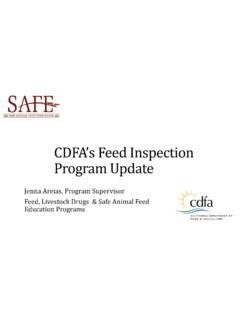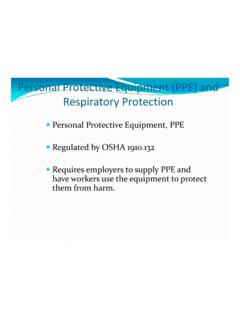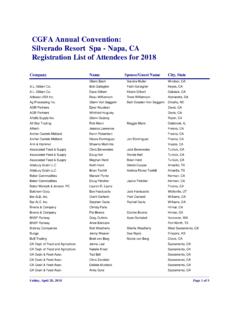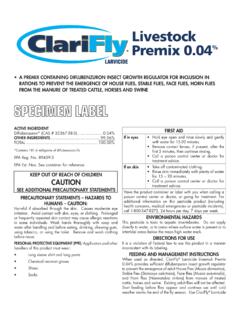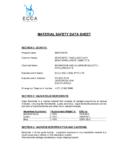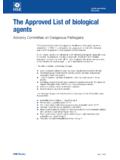Transcription of Final Rule for Preventive Controls for Animal Food
1 Final Rule for Preventive Controls for Animal food THE FUTURE IS NOW. 1. Background Current Good Manufacturing Practice, Hazard Analysis, and Risk-Based Preventive Controls for food for Animals Originally proposed: October 29, 2013. Supplemental proposal: September 29, 2014. Public comments: More than 2,400 for the original proposal; more than 140 for the supplemental proposal Final rule: September 17, 2015. 2. Key Areas Addressed Establish Current Good Manufacturing Practices (CGMPs). Hazard Analysis and Risk-Based Preventive Controls Each facility is required to implement a written food safety plan that focuses on preventing hazards in Animal foods 3. Who is Covered? In general, facilities that manufacture, process, pack or hold Animal food Facilities required to register with FDA under sec. 415 of the FD&C Act Not farms Applies to domestic and imported food There are some exemptions and modified requirements for certain facilities 4.
2 Exemptions from CGMPs Establishments solely engaged in holding or transportation of one or more RACs New: Hulling, shelling, and drying nuts and hulls (without further manufacturing/processing). New: Cotton ginning (without further manufacturing/processing). 5. Definition of Holding Modified the definition of holding to include activities performed incidental to storage of an Animal food ( , for safe or effective storage of that Animal food ) and activities performed as a practical necessity for distribution of that Animal food . These include blending the same RAC and breaking down pallets, but not activities that would transform a RAC into a processed food . 6. Impact of Farm Definition on Feed Mills Feed mills that are part of a farm are exempt from registering as a food facility and are not subject to rule For the feed mill to be part of the farm: Raising animals and feed mill are under same management in one general location, AND.
3 Animal food made at the mill is ONLY fed to animals under the farm's management 7. Impact of Farm Definition on Feed Mills cont. Feed mills that are not part of a farm and are required to register as a food facility are subject to rule Examples include: Independent feed mill Feed mill that makes food for contract farms On-farm feed mill that makes food for animals under different management than the farm 8. Qualified Facilities Very small businesses are qualified facilities exempt from the full requirements for hazard analysis and risk-based Preventive Controls (but still have some requirements). Average less than $ per year in sales of Animal food plus the market value of Animal food manufactured, processed, packed or held without sale 9. Requirements for a Qualified Facility Attestation the facility is a qualified facility;. AND. Attestation that hazards have been identified and that Preventive Controls have been implemented and are being monitored; OR.
4 Attestation facility is in compliance with an applicable non-Federal food safety law 10. Requirement for Training Individuals who manufacture, process, pack, or hold Animal food must be qualified to perform their assigned duties Qualifications can come from education, training, or experience (or combination). Must have training in principles of Animal food hygiene and Animal food safety Training must be documented 11. CGMPs FDA Action in Final Rule Revised the CGMPs based on comments and existing industry standards Modified the requirements to be less prescriptive while maintaining a baseline to protect Animal food against contamination that would be harmful to public health 12. CGMPs Personnel Plant and grounds Sanitation Water supply and plumbing Equipment and utensils Plant operations Holding and distribution Holding and distribution of human food by-products for use as Animal food 13.
5 CGMPs (cont.). No requirements for hair nets, beard covers, special outer garments, or gloves Hand washing as necessary and appropriate Other precautions necessary to protect the Animal food 14. CGMPs (cont.). Require cleaning of Animal food -contact surfaces of equipment, no sanitizing requirement unless necessary Water that contacts Animal food or Animal food -contact surfaces or packaging materials must be safe for its intended use 15. CGMPs (cont.). Less emphasis on sanitation and more emphasis on producing safe Animal food Less stringent requirements for raw materials and ingredients Less specific requirements for equipment and utensils Overall more flexibility 16. Human food By-products for Use as Animal food Human food by-products are not subject to Animal food rule (except for provisions for holding and distribution) if: Human food is produced in compliance with human food CGMPs and all applicable food safety requirements Not further processed 17.
6 Holding and Distribution of Human food By-Products Must be held in a manner that protects against contamination Containers cleaned as necessary Must be accurately identified during holding Labeling that identifies common or usual name must be affixed to or accompany when distributed Shipping containers examined before use 18. Further Processing of Human food By-Product Further processing of by-products requires compliance with CGMPs Firm can choose to follow either the human food or Animal food CGMPs for the processing Requires a hazard analysis If hazards identified, would need to implement a Preventive control 19. food Safety Plan Hazard analysis Preventive Controls Supply-chain program Recall plan Procedures for monitoring Corrective action procedures Verification procedures 20. PC Qualified Individual A qualified individual who has successfully completed training in the development and application of risk-based Preventive Controls at least equivalent to that received under a standardized curriculum recognized as adequate by FDA or is otherwise qualified through job experience to develop and apply a food safety system.
7 21. food Safety Plan . Hazard Analysis Hazard identification must consider known or reasonably foreseeable biological, chemical, and physical hazards These could occur naturally, be unintentionally introduced, or be intentionally introduced for economic gain 22. food Safety Plan . Hazard Analysis Evaluation of hazards must include: consideration of severity of illness/injury and probability of occurrence in absence of Preventive Controls consideration of effect of factors such as formulation and processing of Animal food , facility, equipment, ingredients, intended use Evaluation outcome is whether there is a hazard(s) requiring a Preventive control 23. food Safety Plan . Preventive Controls Measures required to ensure that hazards are significantly minimized or prevented. These include: Process Controls Sanitation Controls Supply-chain Controls Recall plan 24. food Safety Plan.
8 Preventive Controls Not required when hazard is controlled by another entity later in the distribution chain Disclose that Animal food has not been processed to control an identified hazard Obtain assurances hazard will be controlled 25. food Safety Plan - Monitoring Facility must have written procedures, including the frequency they are to be performed, for monitoring the Preventive Controls (as appropriate to the nature of the Preventive control ). Monitoring must be documented in records subject to verification 26. food Safety Plan Corrective Actions and Corrections Facility must have written corrective action procedures for when Preventive Controls are not properly implemented Identify and correct a problem Reduce likelihood of occurrence Evaluate Animal food for safety Prevent adulterated Animal food from entering commerce 27. food Safety Plan - Verification Includes (as appropriate to the facility, Animal food and nature of the Preventive control ): Validation of Preventive Controls Verification of monitoring and corrective actions Calibration of process monitoring and verification instruments Product testing, environmental monitoring Records review 28.
9 Reanalysis of food Safety Plan At least every three years, or: Whenever there is a significant change in activities at the facility that creates the potential for a new hazard or a significant increase in one previously identified When there is new information about potential hazards associated with an Animal food After an unanticipated food safety problem When a Preventive control is ineffective 29. Supply-Chain Program When the control is applied before receipt ( supply-chain applied control ). Must have a risk-based supply-chain program to ensure control of hazards in raw materials and other ingredients. 30. Supply-Chain Program Use of approved suppliers Determine, conduct, and document appropriate supplier verification activities Onsite audits (default for most serious hazards). Sampling and testing Review of relevant food safety records Other as appropriate Activity and frequency based on nature of hazard, where it is controlled and supplier performance 31.
10 Compliance Dates . Supply-Chain Program Separate compliance dates have been established for the supply-chain program provisions to accommodate compliance dates for suppliers of different sizes and subject to different rules ( , Produce Safety Standards, Foreign Supplier Verification Program). 32. Records Original or true copies with actual values and observations Identify the facility, lot code, date/time, signature/initials Exempt from part 11 requirements unless required by another regulation Retain for 2 years 33. Compliance Dates Business Size CGMP Compliance PC Compliance Other Businesses 1 year 2 years Small Business* 2 years 3 years Very Small Business 3 years 4 years *Small Business business with fewer than 500 full-time equivalent employees Very Small Business Average less than $ per year in sales of Animal food plus the market value of Animal food manufactured, processed, packed or held without sale 34.
